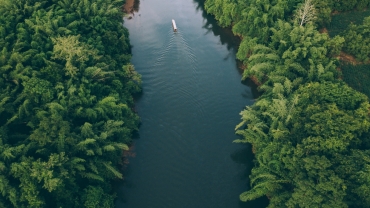What are the risks due to biodiversity loss?
Andreas: Firstly, let me tell you benefits of biodiversity. Ecosystem services delivered by biodiversity, such as crop pollination, water purification, flood protection and carbon sequestration, are vital to human well-being. Marine and terrestrial ecosystems are the sole sinks for anthropogenic carbon emissions, with a gross sequestration of 5.6 gigatons of carbon per year. Globally, these services are worth an estimated USD 125-140 trillion per year. This is more than one and a half times the size of global GDP, a very substantial amount.
Now, with biodiversity loss, the direct effects to the real economy rise into the billions: roughly USD 400 billion of global crop output is at risk due to the loss of bees and other pollinators, while the overexploitation of fishing resources is creating a USD 50 billion shortfall each year. Generally, land-based ecosystem services worth around USD 50 billion are lost each year.
Thomas: What this illustrates is that much of what has been reported as economic growth is, in fact, a drawdown on the natural capital of our planet, if we fully account for the biodiversity loss it caused. If you look into the future, the associated cost of inaction could rise steeply to the equivalent of 7% of GDP by 2050.
What are concrete financial risks associated with biodiversity loss?
Andreas: Biodiversity-related financial risks could materialise as:
- increased cost of capital or lending requirements
- write-downs of asset value and write-offs of assets
- increased insurance claims
- higher premiums or loss of insurance value
- increased risk of default
- loss of investment value related to reputational risks
- changes in market value of businesses.
Can you give an example of how the loss of biodiversity may affect industries?
Thomas: Take the pharmaceutical industry, for example. A lot of the substances developed are based on plants and animal species. About 70% of cancer drugs are of natural origin. Due to the current rate of biodiversity loss, the pharmaceutical industry is being deprived of a reservoir that may contain substances vital to developing new drugs. Replacing these in labs would come at an enormous cost.
Andreas: Another heavily affected industry is forestry, which has 13 million jobs depending on it. Forests provide services such as protection from avalanches, fire regulation, regulation of the water cycle and carbon sequestration. The timber, pulp and paper sectors benefit greatly from biodiversity: forest products account for USD 247 billion of global trade exports. The food industry is another example – 70% of the 124 most commonly used crops in agriculture depend on insect pollination. If pollinators disappear, how will apple trees be pollinated? Imagine the cost implications of replacing pollination with human labour.
How can financial players integrate biodiversity-related risks into their current risk processes?
Andreas: We believe it is evident that biodiversity-related risks need to be integrated into the conventional risk assessment, evaluation and management process. And I think this is where the biggest gap is today, as it is not being done at all. However, based on the TCFD recommendations, we suggest that biodiversity-related financial risks be classified into four categories, as follows.
First, we have transition risks. These are risks related to the transition to an economy which conserves and restores biodiversity. These risks may entail extensive regulatory, legal, technological and market changes and may lead to reputation risks.
More obviously, there are the physical risks that are related to biodiversity loss. The materialisation of biodiversity risks can damage assets and infrastructure or cause a deterioration in supply chains or business operations.
Third, we have litigation risks pertaining to biodiversity loss and breaches of the underlying legal frameworks.
And lastly, there is the systemic risk of biodiversity loss. It includes the exogenous biodiversity risk to the smooth functioning of the financial system as well as the risk created endogenously by the financial system.
We recommend that biodiversity-related financial risks be incorporated into the risk types that already exist in the traditional risk management framework.
What are your recommendations to the different stakeholders?
Andreas: In our report, we recommend that states agree to bring financial flows in line with biodiversity conservation and restoration at Kunming (China) in 2020 because risks associated with loss of biodiversity will become increasingly important in the coming years. We also mention that a task force on nature-related financial disclosures is needed and should drive standardised disclosure of nature-related risks, taking into consideration the physical, transition, litigation and systemic financial risks that stem from biodiversity loss.
Equally important is that financial regulators and central banks address the systemic risk stemming from biodiversity loss for the financial system by running stress tests based on aligned and common practices. We also recommend that all financial actors integrate biodiversity-related financial risks into their risk management framework by measuring and disclosing them. They should also seize and secure opportunities offered by ecosystem services, like flood protection, pollination, clean water, fertile soils and adaptation to climate change.
Thomas: Facing the worst man-made crisis ever, humanity is in urgent need of a new deal for nature and people. This is a call to action for all stakeholders and a call to work together – because no single stakeholder group can solve the problem on its own. We must act now; nature is definitely too big to fail.











